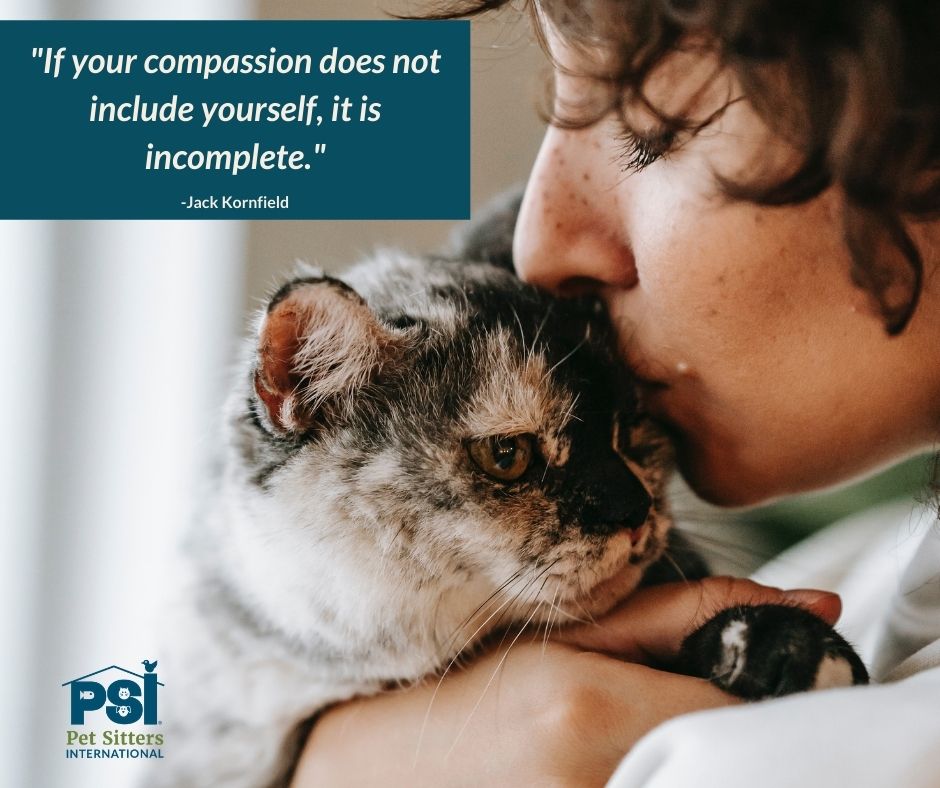Pet Sitter Compassion Fatigue: What does it mean?
By Beth Stultz-Hairston | Pet Sitters International
Note: Many of the tips below can help pet sitters prevent burnout or work through compassion fatigue, but keep in mind this advice does not provide or replace advice from a healthcare or mental-healthcare professional—so if your symptoms are not manageable, consult an expert!

What is the definition of compassion fatigue?
In the Figley Institutes's Basics of Compassion Fatigue Workbook, compassion fatigue is explained in the following way:
"Compassion fatigue is a recent concept that refers to the emotional and physical exhaustion that can affect helping professionals and caregivers over time. It has been associated with a gradual desensitization to patient stories, a decrease in quality care for patients and clients (sometimes described as “poor bedside manners”), an increase in clinical errors, higher rates of depression and anxiety disorders among helpers, and rising rates of stress leave and degradation in workplace climate. Helping professionals have also found that their empathy and ability to connect with their loved ones and friends is impacted by compassion fatigue. In turn, this can lead to increased rates of stress in the household, divorce, and social isolation. The most insidious aspect of compassion fatigue is that it attacks the very core of what brings helpers into this work: their empathy and compassion for others."
Burnout is typically associated with where you work—and if you leave the job, you would leave the burnout. [An example could be developing burnout from a specific job or employer that constantly asked you to work overtime, paid very little and didn’t encourage positive relationships between co-workers.]
On the other hand, compassion fatigue is more associated with the work you do—so it follows you wherever you go. [For example, while a nurse could go to work for a different hospital, the fatigue he or she experiences from dealing with life and death situations, seeing individuals suffer, etc. would still be present].
Symptoms of compassion fatigue may include:
- Bottled-up emotions
- Impulse to rescue anyone (or anything) in need
- Isolation from others
- Sadness and apathy
-
Needs to voice excessive complaints about management and co-workers
- Lack of interest in self-care practices
- Recurring nightmares or flashbacks
- Persistent physical symptoms
- Mental tiredness or difficulty concentrating
- Prone to accidents
Charles Figely, Ph.D., Director of the Florida State University Traumatology Institute, defines compassion fatigue as emotional exhaustion caused by the stress of caring for traumatized or suffering animals or people. While this term is more often used to describe the trauma that happens to animal-shelter employees or pet-rescue workers, it is also most certainly experienced by professional pet sitters. While you may not deal with suffering pets on a regular basis, you certainly deal with sickness and death of pets in your care—and it can take a toll on your health and happiness.
Those experiencing compassion fatigue may also display symptoms at home including being withdrawn, having a decreased interest in intimacy, projecting anger or blame, impacted parenting or isolation from friends.
What are the causes of compassion fatigue for professional pet sitters?
In a previous PSI member webinar, these common causes of compassion fatigue in pet-care professionals were shared:
- Placing needs of others before your own
- Unresolved past trauma and pain
- Lack of healthy life coping skills
- Lack of self awareness that limits growth
- Giving care to others under stress
- Lack of personal boundaries
- Inability to communicate needs
While the term "compassion fatigue" was introduced in the 1970's (first used in the nursing field), there has still been very little research and study into the impact of compassion fatigue on those in the animal-care fields. However, according to Dr. Robert G. Roop, President of the Humane Society University and author of Compassion Fatigue in the Animal-Care Community, compassion fatigue is most prevalent in the animal care field than in any other field. While Dr. Roop's study focused primarily on compassion fatigue in the veterinary field, some of its findings can be applied to other pet-industry professions.
Professional pet sitters likely have more contact with pets than any other pet professional, and Pet Sitters International believes that there must be an increased focus on the impact of compassion fatigue in the professional pet-sitting industry.
Because professional pet sitting is by definition a career that provides care and service, professional pet sitters can be prone to compassion fatigue. Professional pet sitters form specific attachments because of the work they do that cannot be eliminated and can result in compassion fatigue.
Professional pet sitters experience very unique attachments and consequences that can result in compassion fatigue:
- Because pet sitters have repeat, long-term clients, relationships are formed.
- When pet is ill, pet sitters often provide emotional support to clients.
- When pet is ill or injured, pet sitters may also provide medical support.
- When a pet dies, pet sitters experience grief.
- When a (human) client dies, pet sitters experience grief.
- When family moves or discontinues servie, pet sitters experience loss.
How can professional pet sitters combat compassion fatigue?
Because compassion fatigue is associated with the work you do (and not just your specific working conditions), the causes cannot be eliminated like you can the causes of pet sitter burnout. However, understanding what compassion fatigue is, recognizing the symptoms and identifying the causes can help you prevent, address or manage compassion fatigue.
Here are some tips for addressing the six unique attachments and consequences (noted above) that professional pet sitters face:
- Support and enjoy the relationships with repeat clients.
- Let yourself feel and express concern for pets that are ill/injured.
- Understand the pet's disease process and care.
- Honor the loss of a pet.
- Honor the loss of a client.
- Continue the relationship beyond the move.
To prevent and combat compassion fatigue, it's very important for professional pet sitters to develop a self care plan. By increasing your "compassion satisfaction," you can decrease compassion fatigue.
In her article, "Compassion Fatigue: Emotional Burnout in the Animal Care Field," Peternity.com Founder Colleen Mehelich explains that compassion fatigue is "what we experience when we are out of balance from caring for others more than we care for ourselves" and offers these tips for bringing your caring nature back to also focus on yourself:
- Honor yourself and feel proud for the difference you're making.
- Take a look at "why" you are so dedicated to helping animals.
- Practice creating emotional boundaries.
- Carve out time in your life to relax and play.
- Work on identifying your own issues.
- Accept your reality and your limitations.
Read the entire article,"Compassion Fatigue: Emotional Burnout in the Animal Care Field," here.







